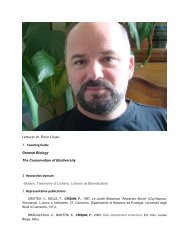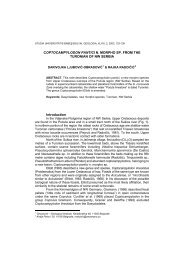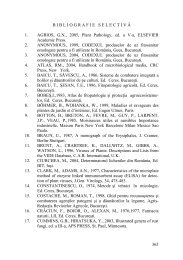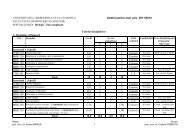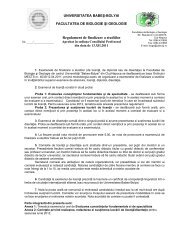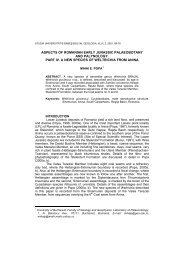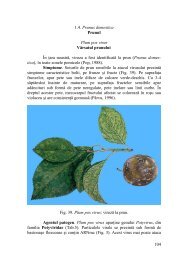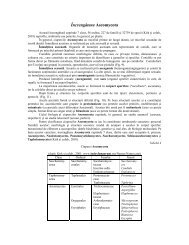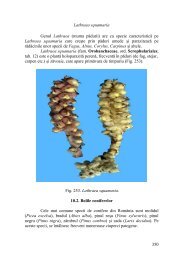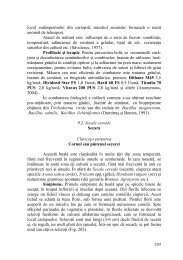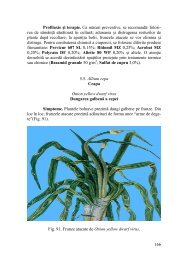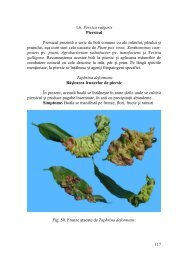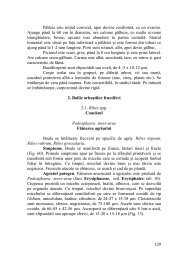Towards mineralogical and geochemical reference groups for some ...
Towards mineralogical and geochemical reference groups for some ...
Towards mineralogical and geochemical reference groups for some ...
Create successful ePaper yourself
Turn your PDF publications into a flip-book with our unique Google optimized e-Paper software.
Studia Universitatis Babeş-Bolyai, Geologia, 2009, 54 (2), 41 – 51<br />
<strong>Towards</strong> <strong>mineralogical</strong> <strong>and</strong> <strong>geochemical</strong> <strong>reference</strong><br />
<strong>groups</strong> <strong>for</strong> <strong>some</strong> Bronze Age ceramics<br />
from Transylvania (Romania)<br />
Volker HOECK 1,2* , Corina IONESCU 2 , Lucreţia GHERGARI 2 & Carmen PRECUP 2<br />
1 University of Salzburg, Department of Geography <strong>and</strong> Geology, 34 Hellbrunnerstr., 5020 Salzburg, Austria<br />
2 Babeş-Bolyai University, Department of Geology, 1 Kogălniceanu Str., 400084 Cluj Napoca, Romania<br />
Received April 2009; accepted June 2009<br />
Available online September 2009<br />
*Correspondence: V. Hoeck (volker.hoeck@sbg.ac.at)<br />
ABSTRACT. Based on their chemical composition ceramic shards from three Bronze Age sites in Transylvania,<br />
i.e., Copăceni, Derşida <strong>and</strong> Palatca respectively, were distinguished by major, trace, <strong>and</strong> RE elements. Within the<br />
Copăceni samples, two sub<strong>groups</strong> (A <strong>and</strong> B) showing different chemistry <strong>and</strong> mineralogy were additionally<br />
separated out. The link between chemistry <strong>and</strong> mineralogy showed clearly the important contribution of the temper<br />
to the overall chemistry of the ceramic shards. In turn, the chemistry facilitated the provenance study of the raw<br />
materials, which were collected in the vicinity of the sites. In combination with the mineralogy of the ceramics, the<br />
chemical analyses can serve as a basis <strong>for</strong> a <strong>geochemical</strong> <strong>reference</strong> set used by further studies.<br />
Key words: ancient ceramics, Bronze Age, mineralogy, geochemistry, archaeometry, Romania<br />
INTRODUCTION<br />
Compositionally, the ancient ceramics can be regarded<br />
as artificial rocks <strong>for</strong>med during a short living thermal<br />
event from clays mixed with tempering material, e.g.,<br />
s<strong>and</strong>s, potshards, <strong>and</strong> others.<br />
The ceramic is a two-component system consisting of a<br />
major component, the clayey matrix <strong>and</strong> clasts as the<br />
second one. The latter originate mainly from the tempering<br />
material added by the potter <strong>and</strong> partly from the raw clay.<br />
The clasts may consist of one or more of the following<br />
types: crystalloclasts, lithoclasts, ceramoclasts <strong>and</strong><br />
bioclasts (Ghergari et al., 1999; Ionescu <strong>and</strong> Hoeck, 2008).<br />
Chemical analyses have been used since several years in<br />
archaeometry to group <strong>and</strong> classify ancient ceramics, <strong>and</strong><br />
<strong>for</strong> provenance studies (Yoon et al., 2001; Gliozzo <strong>and</strong><br />
Memmi Turbanti, 2004; Mirti et al., 2004; Barone et al.,<br />
2005; Belfiore et al., 2007).<br />
Taking into account the compositional complexity of<br />
the ceramics, the chemical analyses of ceramic shards have<br />
to be treated with utmost care in particular <strong>for</strong> the search<br />
of possible sources. The use of chemical data of whole<br />
ceramic fragments <strong>and</strong> their interpretation requires<br />
additionally a detailed <strong>mineralogical</strong> <strong>and</strong> petrographic<br />
study.<br />
The paper presents the results of the first <strong>geochemical</strong><br />
study on Bronze Age ceramics in Romania done in order<br />
to delineate distinctive features <strong>for</strong> each site as base <strong>for</strong><br />
future analogies. We will show here that sound results can<br />
be achieved provided care is taken in h<strong>and</strong>ling the<br />
chemical data <strong>and</strong> connecting with the mineralogy <strong>and</strong><br />
petrography.<br />
ARCHAEOLOGICAL AND GEOLOGICAL<br />
BACKGROUND<br />
In Romania <strong>and</strong> in particular in Transylvania, several<br />
Bronze Age settelements rich in ceramics artefacts, e.g.<br />
Ilişua, Copăceni, Palatca, Derşida were investigated. So<br />
far, only <strong>mineralogical</strong>-petrographic studies were carried<br />
out (Ionescu et al., 2005, 2006, 2007a, b; Precup et al.,<br />
2006 a, b; 2007, 2008; Precup, 2008). The present study<br />
deals with ceramic potshards from Copăceni, Derşida <strong>and</strong><br />
Palatca (Fig. 1), provided by the National Museum of<br />
History of Transylvania from Cluj-Napoca.<br />
Fig. 1. Location of the Copăceni - Early Bronze Age (1),<br />
Derşida - Middle Bronze Age (2) <strong>and</strong> Palatca - Late Bronze Age<br />
(3) sites within the Romanian territory.
42<br />
The Copăceni site is located 25 km south of Cluj-<br />
Napoca (site 1 in Fig.1) <strong>and</strong> was dated as Early Bronze in<br />
age (~2000 to 1600 B.C.). Small <strong>and</strong> medium-sized<br />
ceramic table ware was found at the site. The high amount<br />
<strong>and</strong> typological diversity of the ceramics remnants, <strong>and</strong> the<br />
finding of similar ware in several archaeological sites in<br />
Transylvania supported the outline of the most important<br />
cultural phenomenon of the second half of the Early<br />
Bronze age, i.e. the „Copăceni-type” (Rotea, 1993, 1997).<br />
Geologically, the site is located at the contact of the<br />
Transylvanian Depression with the units of the Northern<br />
Apuseni Mts. <strong>and</strong> Southern Apuseni Mts., respectively<br />
(Lupu et al., 1967). The Cenozoic sediments of the<br />
Transylvanian Depression are represented by Palaeocene<br />
continental red clays, Eocene marls, clays, limestones <strong>and</strong><br />
s<strong>and</strong>stones, Badenian conglomerates, limestones ±<br />
celestine <strong>and</strong> barite (Imreh <strong>and</strong> Imreh, 1959; Savul et al.,<br />
1964), gypsum, salt, volcanic tuffs <strong>and</strong> s<strong>and</strong>stones,<br />
Sarmatian marls, s<strong>and</strong>y marls, s<strong>and</strong>stones <strong>and</strong> s<strong>and</strong>s,<br />
Upper Pleistocene <strong>and</strong> Holocene gravels <strong>and</strong> s<strong>and</strong>s.<br />
Lithologically, the units belonging to the Northern<br />
Apuseni Mts. (Săndulescu, 1984; Pană et al., 2002;<br />
Balintoni et al., 2009) include Palaeozoic <strong>and</strong> Mesozoic<br />
metamorphics (micaschists, quartzites, gneises, granitoids,<br />
amphibolites, skarns, marbles) <strong>and</strong> Late Cretaceous-Early<br />
Palaeogene magmatites (granodiorites, dacites, diorites,<br />
<strong>and</strong>esites). The Southern Apuseni Mts. units consists of<br />
Late Jurassic Isl<strong>and</strong> Arc Volcanics (basaltic <strong>and</strong>esites to<br />
rhyolites, <strong>and</strong> associated pyroclastics), overlain by<br />
Tithonian plat<strong>for</strong>m limestones.<br />
The Derşida site is located in western Romania, 90 km<br />
in straight line NW of Cluj-Napoca (site 2 in Fig. 1). The<br />
ceramic findings consist of various table ware, decorated<br />
with incisions <strong>and</strong> assigned to the „Wietenberg Culture”<br />
(Chidioşan, 1980) of Middle Bronze Age (~1600 - 1300<br />
B.C.). Geologically, the area belongs to the eastern part of<br />
the Pannonian Basin. Mainly Badenian conglomerates,<br />
s<strong>and</strong>stones, marls <strong>and</strong> limestones, Sarmatian s<strong>and</strong>stones,<br />
marls, conglomerates <strong>and</strong> s<strong>and</strong>s, Pannonian clays, marls,<br />
s<strong>and</strong>s <strong>and</strong> gravels, Upper Pleistocene s<strong>and</strong>s, gravels, clays<br />
<strong>and</strong> loess <strong>and</strong> Holocene gravels <strong>and</strong> s<strong>and</strong>s occur in the area<br />
(Bleahu et al 1966, Giuşcă et al., 1967; Răileanu et al.,<br />
1967). <strong>Towards</strong> southeast, in the Meseş Mts. (Northern<br />
Apuseni Mts.), the metamorphics consisting of<br />
micaschists, garnet-micaschists, amphibolites, quartzites<br />
<strong>for</strong>m a fault bounded, NE-SW oriented narrow wedge<br />
(Giuşcă et al., 1967; Răileanu et al., 1967). Late<br />
Cretaceous-Early Paleogene dacitic <strong>and</strong> Neogene <strong>and</strong>esitic<br />
small bodies can be also found in the Meseş Mts.<br />
The Palatca site is located 30 km in straight line ENE<br />
from Cluj-Napoca (site 3 in Fig. 1), in the Transylvanian<br />
Basin. The site is dated as Late Bronze Age (~1300 to<br />
1000 B.C.) <strong>and</strong> several thous<strong>and</strong>s fragments of various<br />
decorated pottery were found (Rotea, 1997). Geologically,<br />
around the site only sedimentary <strong>for</strong>mations such as<br />
Badenian marls, s<strong>and</strong>stones, salt <strong>and</strong> volcanic tuffs, <strong>and</strong><br />
Sarmatian marls, s<strong>and</strong>s <strong>and</strong> gravel are found. The<br />
Holocene s<strong>and</strong>s <strong>and</strong> gravels fill in the small valleys.<br />
<strong>Towards</strong> west, at 10 km in straight line, the Someş river<br />
shows large terasses, covered by Upper Pleistocene s<strong>and</strong>s<br />
<strong>and</strong> gravels (Răileanu et al., 1967). In the Badenian<br />
<strong>for</strong>mations the „Dej tuff” level occurs, cropping out west<br />
of Palatca (Ciupagea et al., 1970; Szakacs, 2000). In the<br />
close vicinity of the site, the Sarmatian <strong>for</strong>mations contain,<br />
Studia UBB, Geologia, 2009, 54 (2), 41 – 51<br />
Hoeck et al.<br />
intercalated between marls <strong>and</strong> s<strong>and</strong>s, the „Ghiriş tuff”,<br />
compositionally a pyroxene <strong>and</strong>esite, with a high amount<br />
of amphiboles <strong>and</strong> pyroxenes (Ciupagea et al., 1970).<br />
SAMPLES AND METHODS<br />
For the identification of the mineral phases, 16 thin<br />
sections were cut from Copăceni, 22 from Derşida <strong>and</strong> 28<br />
from Palatca samples respectively, were studied in<br />
polarized light. Due to the small size of the shards, only 5<br />
ceramic samples from Derşida, 5 samples from Copăceni<br />
<strong>and</strong> 7 samples from Palatca were chemically analyzed <strong>for</strong><br />
major, minor, trace <strong>and</strong> RE elements at the Acme<br />
Analytical Laboratories Ltd. Vancouver (Canada). For<br />
SiO2, Al2O3, Fe2O3, CaO, MgO, Na2O, K2O, MnO, TiO2,<br />
P2O5, MnO, Cr2O3, Ba, Ni, Sc analyses by ICP-ES<br />
(Spectro Ciros Vision) <strong>and</strong> the ICP-MS analyses (Perkin-<br />
Elmer-Elan 6000/9000) <strong>for</strong> REE <strong>and</strong> incompatible<br />
elements were done by LiBO2/Li2B4O7 fusion in a graphite<br />
crucible at 980°C <strong>and</strong> subsequently dissolution in HNO3<br />
(5%). This procedure was also applied <strong>for</strong> Co, Cs, Ga, Hf,<br />
Nb, Rb, Sr, Ta, Th, U, V, W, Zr, Y, La, Ce, Pr, Nd, Sm,<br />
Eu, Gd, Tb, Dy, Ho, Er, Tm, Yb, <strong>and</strong> Lu. The precious <strong>and</strong><br />
base metals 2+ (Mo, Cu, Pb, Zn, Ni, As) were digested in<br />
aqua regia <strong>and</strong> also analyzed by ICP-MS. Loss of ignition<br />
(LOI) was determined by weight loss after ignition at<br />
950°C <strong>for</strong> 90 minutes. The Ctot was determined by a LECO<br />
furnace.<br />
RESULTS<br />
Mineralogy <strong>and</strong> petrography<br />
For a sound interpretation of the geochemistry of the<br />
ceramics, a brief presentation of the mineralogy <strong>and</strong><br />
petrography is neccessary.<br />
The Copăceni pottery has red or dark brown colour,<br />
either homogeneously distributed across the ceramic body<br />
or <strong>for</strong>ming a „s<strong>and</strong>wich-type” zoning. The observations<br />
made on thin sections in polarized light show two main<br />
ceramic types:<br />
- Type A ceramics (Fig. 2a), composed of an opaque <strong>and</strong><br />
more or less isotropic, amorphous clayish matrix.<br />
Embedded are mainly clasts of quartz <strong>and</strong> plagioclase, as<br />
well as muscovite. Moreover, biotite, amphiboles,<br />
pyroxenes, epidote, allanite(?) <strong>and</strong> opaque minerals were<br />
identified. As lithoclasts, fragments of micaschists,<br />
quartzites, skarn-like rocks <strong>and</strong> granitoids are visible.<br />
- Type B ceramics (Fig. 2b) consists of a translucent,<br />
relatively anisotropic matrix. The crystalloclasts are<br />
composed of quartz, plagioclase <strong>and</strong> rare K-feldspar.<br />
Muscovite lamellae <strong>and</strong> rare amphibole can be seen. The<br />
lithoclasts consist of fragments of volcanic acidic tuffs,<br />
various volcanics (rhyolites, basaltic <strong>and</strong>esites, dacites)<br />
<strong>and</strong> chert. The texture in either preferentially oriented,<br />
parallel to the ceramic wall or shows a r<strong>and</strong>om orientation<br />
of lamellar phases <strong>and</strong> pores. One of the main<br />
characteristics <strong>for</strong> this ceramic type is the presence of high<br />
amount of plagiclase <strong>and</strong> volcanic acidic tuff fragments.<br />
The Derşida samples show a wide range of colours,<br />
from light brown to dark brown, in general<br />
inhomogeneously distributed within the ceramic wall. The<br />
<strong>mineralogical</strong> study revealed a microcrystalline anisotropic
<strong>Towards</strong> <strong>mineralogical</strong> <strong>and</strong> <strong>geochemical</strong> <strong>reference</strong> <strong>groups</strong> <strong>for</strong> <strong>some</strong> Bronze Age ceramics<br />
(Fig. 2c), <strong>some</strong>times amorphous isotropic (Fig. 2d) clayish<br />
matrix. Small crystalloclasts of quartz, K-feldspar,<br />
plagioclase, muscovite, rare amphibole <strong>and</strong> pyroxene, besides<br />
large-sized various lithoclasts are present. The most<br />
characteristic are the amphibolitic schists, quartzites,<br />
granodiorites <strong>and</strong> altered <strong>and</strong>esite fragments. Soil concretions<br />
are also identified, as well as rare ceramoclasts. The texture is<br />
in general unoriented, with few exceptions when it shows a<br />
slight parallel arrangement of lamellar minerals <strong>and</strong> pores.<br />
The Palatca samples show an highly inhomogeneouslycoloured<br />
ceramic body, ranging from red to almost black.<br />
Very often a s<strong>and</strong>wich-type zoning can be noticed across the<br />
ceramic wall. The wide range of compositions do not allow to<br />
separate out <strong>some</strong> <strong>mineralogical</strong>-petrographic sub<strong>groups</strong>.<br />
The matrix is either microcrystalline-anisotropic<br />
(Fig. 2e, f) or almost amorphous-isotropic. The clasts vary<br />
from sample to sample. Quartz, muscovite, K-feldspar <strong>and</strong><br />
plagioclase (Fig. 2e) <strong>and</strong> various lithoclasts, such as<br />
quartzites, clays, s<strong>and</strong>stones are common. Andesite <strong>and</strong><br />
pyroxenes are restricted to two samples (37-1 <strong>and</strong> 37-14).<br />
Ceramoclasts occur frequently (Fig. 2f). Calcite is rare <strong>and</strong><br />
occurs as burial deposition on fissures <strong>and</strong> voids.<br />
As a general remark, the ratio between the lutitic/partly<br />
siltic grain size (matrix) over silt+arenite+rudite grains<br />
(clasts) is higher in Copăceni (54%) <strong>and</strong> Palatca (56%)<br />
compared with Derşida (48%). In individual samples this<br />
ratio might be reversed. The values are given as arithmetic<br />
mean.<br />
Fig. 2. Microphotographs of thin sections of Bronze Age ceramics (polarized light, crossed polarizators, scale bar = 0.5 mm. a) Sample 36-5<br />
Copăceni A. Almost isotropic matrix (M) comprising clasts of quartzite (Qtz), diopside skarn (Sk) <strong>and</strong> micaschist (Mc); b) Sample 36-3<br />
Copăceni B. Anisotropic, oriented matrix (M), with small crystalloclasts of quartz (Qtz) <strong>and</strong> large clasts of volcanic tuffs (Vt); c) Sample<br />
35-1 Derşida. Isotropic matrix (M) enclosing large lithoclasts of calcareous silt (Scal); d) Sample 35-15 Derşida. Small crystalloclasts<br />
of quartz <strong>and</strong> large clasts of quartzites (Qtz) in an isotropic matrix (M); e) Sample 37-14 Palatca. Anisotropic matrix (M) including a very<br />
large plagioclase clast (Pl) <strong>and</strong> a quartzitic lithoclast (Qtz); f) Sample 37-10 Palatca. Quartz crystalloclasts (white <strong>and</strong> shades of gray<br />
in the image) <strong>and</strong> various ceramoclasts (Cc) embedded in an anisotropic matrix (M).<br />
43<br />
Studia UBB, Geologia, 2009, 54 (2), 41 –51
44<br />
Geochemistry<br />
The original <strong>geochemical</strong> analyses <strong>for</strong> the ceramics<br />
including the major, trace <strong>and</strong> RE elements are listed in<br />
Table 1. All samples show, based on SiO2 content, an<br />
intermediate to acidic chemistry. The CaO content,<br />
ranging from 1.30% to 3.0%, is relatively low. Some<br />
elements e.g., Al <strong>and</strong> Mg show only little variation.<br />
Others, such as K (Figs. 3a-c), Fe (Fig. 3d), Ti, Sr, Zr, Cr<br />
<strong>and</strong> Co show significant variation <strong>and</strong> can be used <strong>for</strong><br />
grouping <strong>and</strong> classification. There is only a weak covariation<br />
among the major elements. A first inspection of<br />
the data from all sites i.e., Copăceni, Derşida <strong>and</strong> Palatca<br />
shows that they are spread to a certain extent not only<br />
between the <strong>groups</strong> but also within the <strong>groups</strong>. Among<br />
these, Na, K, Ca <strong>and</strong> P within the major element group <strong>and</strong><br />
Ni, Co, Cr, Th, Sc, Zr, or Ce as trace elements<br />
respectively, have a certain potential of discrimination.<br />
Due to their similar geo-chemical properties many trace<br />
elements such as Cr/Ni, Cr/Co (Fig. 4a), La/Ce (Fig. 4b),<br />
V/Ti, V/Sc (Fig. 4c), Sc/Ti, Nb/Zr (Fig. 4d), Th/Ta, Zr/Hf<br />
<strong>and</strong> others are positively correlated. For example, the<br />
compatible elements such as Cr, Ni <strong>and</strong> Co are enriched<br />
during magmatic processes in minerals such as olivine,<br />
pyroxenes, amphiboles or spinels. When used as temper<br />
these elements contribute to the overal chemical budget of<br />
the ceramics. In a similar way the amount of Sc, V <strong>and</strong> to<br />
<strong>some</strong> extent Ti in ceramics can increase by adding a<br />
temper rich in amphibole, pyroxene, magnetite or ilmenite.<br />
The same holds <strong>for</strong> feldspar in respect to K, Na, Ba, Sr. On<br />
the other h<strong>and</strong>, <strong>some</strong> elements might be diluted by the<br />
frequent addition of quartz or quartzites as temper. Thus,<br />
the mineralogy of the temper plays an important role in the<br />
chemistry of the ceramics determining the relative<br />
enrichment or depletion of an element upon the mixture<br />
with the clayish matrix.<br />
For the further discussion of the chemistry, the ceramics<br />
were grouped according to their original sites i.e. Copăceni,<br />
Derşida <strong>and</strong> Palatca, respectively. The samples from Derşida<br />
<strong>and</strong> Palatca show a considerable spread in major <strong>and</strong> trace<br />
elements, a division in sub<strong>groups</strong> is not discernable. The five<br />
Copăceni samples show a bi-modal element distribution<br />
(Table 1). Two shards (36-5 <strong>and</strong> 36-8) are markedly different<br />
<strong>for</strong>m the others in respect to a large number of elements.<br />
They are significantly enriched in Fe, Ti, Al, Cr, Ni, Co, Cu,<br />
Zn, Sc, Nb, Zr, Y, V, Hf, Cs, <strong>and</strong> Rb, but relatively depleted<br />
in Si, K, <strong>and</strong> Sr compared to the three other shards (samples<br />
36-1, 36-3, 36-7). Based on the systematic change, we<br />
grouped the <strong>for</strong>mer as Copăceni A <strong>and</strong> the rest as Copăceni<br />
B. This is in accordance with the mineralogy <strong>and</strong> petrography<br />
of Copăceni as described above. The major difference is the<br />
frequent occurrence of biotite, amphibole, pyroxene <strong>and</strong><br />
metamorphics in the Copăceni A, compared with plagioclase,<br />
muscovite, volcanic acidic tuffs <strong>and</strong> volcanics in the<br />
Copăceni B ceramics.<br />
DISCUSSION<br />
The chemical analyses of ceramic shards should serve<br />
multiple purposes as: a) a characterization of a certain<br />
group of ceramics, b) possible separation between<br />
different <strong>groups</strong>, c) possible classification within one<br />
group <strong>and</strong> d) <strong>for</strong> provenance studies. Chemistry is not an<br />
independent variable, each chemical variation reflects the<br />
Studia UBB, Geologia, 2009, 54 (2), 41 – 51<br />
Hoeck et al.<br />
differences in the <strong>mineralogical</strong> composition <strong>and</strong> the<br />
amount of matrix <strong>and</strong> temper.<br />
Major Elements<br />
The classical K2O+Na2O vs. SiO2 diagram (Fig. 3a)<br />
highlights in particular the potential of the alkali elements<br />
to separate the <strong>groups</strong>: the Copăceni samples A <strong>and</strong> B are<br />
nicely separated from the Derşida samples by the<br />
significant higher alkali content of the <strong>for</strong>mer. The Na2O<br />
vs. K2O diagram (Fig. 3b) sorts out to a certain extent all<br />
three <strong>groups</strong>. The grouping is not perfect, but the Derşida<br />
samples exhibit a slightly higher Na2O/K2O ratio than the<br />
others. This is due to the low potassium content in the<br />
matrix (also shown by the electron microprobe analyses -<br />
unpublished data). Copăceni A <strong>and</strong> B have a tendency<br />
towards higher Na2O <strong>and</strong> K2O compared to Palatca.<br />
Several other element ratios have been proposed <strong>for</strong><br />
characterization of sediments in terms of provenance. For<br />
example the Al2O3/TiO2 ratio (Nagarajan et al., 2907) or the<br />
K2O/Al2O3 ratio (Fig. 3c, Table 1) <strong>and</strong> the Index of<br />
Compositional Variability (Cox et al., 1995).<br />
The latter, in short ICV, is calculated from<br />
(Fe2O3+K2O+Na2O+CaO+MgO+MnO+TiO2)/Al2O3 <strong>and</strong> it<br />
may range from 0.01 (clay minerals) to 1000 (non-clay<br />
silicates); it might well be applied also <strong>for</strong> ceramics. Values<br />
between 0.75 <strong>and</strong> 0.95 calculated <strong>for</strong> our samples indicate<br />
<strong>some</strong> contributions from minerals such as muscovite, feldspars<br />
<strong>and</strong>/or amphiboles as observed in the thin sections. The values<br />
are not significantly different between the <strong>groups</strong> (Table 1).<br />
The variation within the one group is in the same range. The<br />
K2O/Al2O3 ratio (Fig. 3c) is lowest in Derşida (0.13 to 0.16),<br />
variable in Palatca <strong>and</strong> Copăceni A (0.12 to 0.20) but higher in<br />
Copăceni B (0.22-0.27). The low K2O/Al2O3 ratio can be<br />
explained by the very low K2O content combined with a<br />
relatively high CaO in the matrix (see above). The Al2O3/TiO2<br />
ratio is larger than 30 <strong>for</strong> Copăceni B (due to the more acidic<br />
clasts) <strong>and</strong> between 16 <strong>and</strong> 20 <strong>for</strong> the rest of the samples.<br />
Trace elements<br />
While Copăceni B samples are easily distinguished by<br />
<strong>some</strong> major elements, the other <strong>groups</strong> are more difficult<br />
to be separated out. Copăceni A has the highest Fe2O3<br />
content (Fig. 3d) <strong>and</strong> additionally the highest Co (Fig. 4a)<br />
<strong>and</strong> Ce (Fig. 4b) values as well as high concentrations of<br />
Cu, Zn, Ti, V <strong>and</strong> Sc (Fig. 4c). This is at least partly due to<br />
the opaque minerals as well as to the relatively high<br />
amount of pyroxene <strong>and</strong> amphiboles as part of the temper.<br />
Both sub<strong>groups</strong> of Copăceni have one specific<br />
characteristic, the high Sr content which is, with 500 to<br />
2000 ppm, a multiple of those from Derşida <strong>and</strong> Palatca<br />
(100-250 ppm). The high Sr content (Fig. 4e) in Copăceni<br />
is most likely caused by the specific localization in close<br />
vicinity of the site of the celestine-bearing Badenian<br />
<strong>for</strong>mations (Imreh <strong>and</strong> Imreh, 1959; Savul et al., 1964).<br />
The differentiation among Derşida <strong>and</strong> Palatca is more<br />
difficult to obtain. Both <strong>groups</strong> overlap to a wide extent<br />
<strong>and</strong> are rarely clearly separated. Among the major<br />
elements, only the Na2O/K2O ratio (Fig. 3b) shows a<br />
certain potential <strong>for</strong> classifying as shown above. In a<br />
similar way as the alkalies, the Zr/Nb ratio (Fig. 4d)<br />
separates both <strong>groups</strong> with a value of below 18 <strong>for</strong> Derşida<br />
<strong>and</strong> above 18 <strong>for</strong> Palatca.
<strong>Towards</strong> <strong>mineralogical</strong> <strong>and</strong> <strong>geochemical</strong> <strong>reference</strong> <strong>groups</strong> <strong>for</strong> <strong>some</strong> Bronze Age ceramics<br />
45<br />
Studia UBB, Geologia, 2009, 54 (2), 41 –51
46<br />
Studia UBB, Geologia, 2009, 54 (2), 41 – 51<br />
Hoeck et al.<br />
Fig. 3. Plot of the ceramics composition in the a) SiO2 vs. Na2O + K2O, b) K2O vs. Na2O, c) Al2O3 vs. K2O <strong>and</strong> d) SiO2 vs. Fe2O3 diagrams.<br />
Legend: full red circles - Copăceni A, empty red circles - Copăceni B, blue diamonds - Derşida, green triangles - Palatca.<br />
Furthermore, there is also a tendency <strong>for</strong> lower Cr <strong>and</strong><br />
Ni values in Derşida but again not clear separation. A<br />
distinct separation among both <strong>groups</strong> is shown only by<br />
the Cs content (Fig. 4f), with about 6 ppm in Palatca <strong>and</strong> 4<br />
ppm in Derşida.<br />
The accuracy <strong>and</strong> the precision of the Cs<br />
determination is in the range of 0.4 ppm <strong>and</strong> 0.2 ppm<br />
respectively, which allows <strong>for</strong> a clear separation. In the<br />
ceramics, Cs can have two sources: either from the<br />
matrix clay (silt) <strong>and</strong>/or from the temper minerals.<br />
According to Cullers (1994) shales <strong>and</strong> clays can<br />
incorporate up to 30 ppm Cs, silts <strong>and</strong> s<strong>and</strong>s less up to 9<br />
<strong>and</strong> 7 ppm Cs respectively. On the other h<strong>and</strong>, Cs can be<br />
inluded in the K-bearing minerals (compare Murariu,<br />
2002) such as feldspar (up to 30 ppm), muscovite<br />
(approx. 20 ppm) <strong>and</strong> particular in biotite (up to 200<br />
ppm). Minor amounts of Cs also occur in amphiboles.<br />
The temper clasts from Derşida are derived mainly from<br />
metamorphics from the Northern Apuseni Mts. <strong>and</strong><br />
contain frequently biotite, muscovite, amphiboles <strong>and</strong> to<br />
a lesser extent K-feldspar. These minerals can contribute<br />
significantly to the overall Cs concentration in these<br />
samples. The Palatca clastics are derived from the<br />
Neogene volcanics, with plagioclase, K-feldspar <strong>and</strong> rare<br />
biotite.<br />
Despite the higher amount of potential Cs-bearing<br />
minerals, the Derşida samples show consistently lower<br />
Cs value than Palatca, where such minerals are rare. This<br />
argues in turn <strong>for</strong> already different Cs levels in the matrix<br />
clays (silts) between Derşida <strong>and</strong> Palatca.<br />
REE <strong>and</strong> Spider diagrams (Figs. 5a-f <strong>and</strong> 6a-f). The<br />
normalisation of the REE <strong>and</strong> other trace elements against<br />
those from mantle, crust or MORB is a powerful tool in<br />
magmatic petrology to infer magmatic processes. This<br />
approach may be also used in interpreting ancient<br />
ceramics. Normalizing the REE against various average<br />
shales such as North American Shale Composite (NASC;<br />
Gromet et al., 1984), Post Archean Australian Shale<br />
(PAAS; Taylor <strong>and</strong> McLennan 1985; Nagarajan et al.,<br />
2007) or European Shale (ES; Haskin <strong>and</strong> Haskin, 1966),<br />
similar patterns appear <strong>for</strong> all samples (Copăceni – Fig. 5a,<br />
Derşida – Fig. 5c, Palatca – Fig. 5e), consistent with the<br />
results <strong>for</strong> other trace elements. For simplicity only the<br />
NASC normalized patterns are shown.<br />
Generally, the REE concentration of the ceramics<br />
normalized against NASC is slightly below 1, varying<br />
from 0.6 to 1. Few samples are above 1 <strong>for</strong> the LREE. The<br />
overall pattern is almost flat with a minor variation, as <strong>for</strong><br />
exmple a small relative enrichment of Ce or a small<br />
depletion of Er. Normalized with NASC, a negative Eu
<strong>Towards</strong> <strong>mineralogical</strong> <strong>and</strong> <strong>geochemical</strong> <strong>reference</strong> <strong>groups</strong> <strong>for</strong> <strong>some</strong> Bronze Age ceramics<br />
anomaly is observed in Copăceni B samples <strong>and</strong> to a lesser<br />
extent in Copăceni A.<br />
The Upper Continental Crust (UCC; Rudnik <strong>and</strong> Gao,<br />
2003) normalized patterns are close to unity, with the<br />
MREE <strong>and</strong> the HREE slightly above (Figs. 5 b,d,f). The<br />
low concentration of REE in the ceramics compared with<br />
the shales is probably due to the temper but it brings at the<br />
same time the ceramics close to the average upper<br />
continental crust. It should be noted here that the<br />
(La/Yb)N ratio is >1 <strong>for</strong> NASC <strong>and</strong>
48<br />
Studia UBB, Geologia, 2009, 54 (2), 41 – 51<br />
Hoeck et al.<br />
Fig. 5. REE diagrams <strong>for</strong> Copăceni (a, b), Derşida (c, d) <strong>and</strong> Palatca (e, f) samples, normalized to NASC (Gromet et al., 1984) (a, c, e)<br />
<strong>and</strong> UCC (Rudnik <strong>and</strong> Gao, 2003) (b, d, f). Legend: full red circles - Copăceni A, empty red circles - Copăceni B,<br />
blue diamonds - Derşida, green triangles - Palatca.<br />
The spider diagrams (Figs. 6a-f) normaliyed against<br />
NASC display similar results (Figs. 6 a, c, e). The patterns<br />
are slightly below unity with <strong>some</strong> irregularirties. Rb, is<br />
low in all <strong>groups</strong>, K in Copăceni A, Derşida <strong>and</strong> Palatca,<br />
Ti only in Copăceni B <strong>and</strong> Cs in Derşida. Ba <strong>and</strong> Y are<br />
high in all samples, Th only in the Copăceni <strong>groups</strong>. The<br />
positive Sr anomaly in Copăceni (Fig. 6a) is clearly<br />
visible. Additionally, Derşida exhibits a small positive Sr<br />
anomaly (Fig. 6c) which is not seen in Palatca (Fig. 6e).<br />
Sample 36-1 from Copăceni B is highest in the REE, Y,<br />
Ba, <strong>and</strong> Th but low in the other elements. Normalized<br />
against the UCC, the pattern is more close to 1, only the<br />
elements between Zr <strong>and</strong> Yb are slightly above (Fig. 6b).<br />
As a whole, the it is more smooth except <strong>for</strong> Sr, with a<br />
positive anomaly <strong>for</strong> Copăceni A <strong>and</strong> B, but contrast to the<br />
NASC normalization with a negative anomaly <strong>for</strong> Derşida<br />
<strong>and</strong> Palatca, which is due to the high Sr values of UCC.<br />
The low Ti (due to low Ti content of the acidic volcanics -<br />
derived temper) values remain <strong>for</strong> the Copăceni B samples<br />
(Fig. 6a).
<strong>Towards</strong> <strong>mineralogical</strong> <strong>and</strong> <strong>geochemical</strong> <strong>reference</strong> <strong>groups</strong> <strong>for</strong> <strong>some</strong> Bronze Age ceramics<br />
Fig. 6. Spider diagrams <strong>for</strong> Copăceni (a, b), Derşida (c, d) <strong>and</strong> Palatca (e, f) samples normalized to NASC (Gromet et al., 1984) (a, c, e)<br />
<strong>and</strong> UCC (Rudnik <strong>and</strong> Gao, 2003) (b, d, f). Legend: full red circles - Copăceni A, empty red circles - Copăceni B<br />
blue diamonds - Derşida, green triangles - Palatca.<br />
Like the bivariate diagrams, the REE normalized <strong>and</strong><br />
the spider diagrams also sort out clearly Copăceni B from<br />
the rest. Both Copăceni <strong>groups</strong> are distinct in their<br />
anomalous high Sr content (Figs. 6 a, b). Derşida<br />
(Figs. 6 c, d) <strong>and</strong> Palatca (Figs. 6 e, f) samples overlap<br />
largely, the <strong>for</strong>mer showing a trend to lower normalized<br />
values. The shale normalized patterns, as shortly discussed<br />
above, are below 1 regarding mainly REE <strong>and</strong> spider<br />
diagrams equally. For the interpetation, the nature of the<br />
temper minerals is important. Pyroxene, amphibole,<br />
biotite, muscovite <strong>and</strong> opaque minerals contribute to the<br />
REE <strong>and</strong> partly to several other trace elements in Copăceni<br />
Studia UBB, Geologia, 2009, 54 (2), 41 –51<br />
49
50<br />
A <strong>and</strong> Derşida. The acidic volcanic fragments, quartz <strong>and</strong><br />
feldspars <strong>for</strong>ming almost exclusively the temper in<br />
Copăceni B <strong>and</strong> Palatca cause more likely a dilution of the<br />
total REE budget. This difference is well visible within the<br />
both Copăceni <strong>groups</strong>, but not discernable between Palatca<br />
<strong>and</strong> Derşida. Most likely the clays were already variably<br />
depleted in respect to the REE <strong>and</strong> trace elements such as<br />
Ti, U, Pb, Nb, <strong>and</strong> Cs concentration. The (La/Yb)N ratios<br />
point in the same direction. They are, depending on the<br />
norm values, similar <strong>for</strong> all <strong>groups</strong> despite the highly<br />
variable temper material suggesting also differences in the<br />
REE content in the raw clays.<br />
CONCLUSIONS<br />
The discussion of the chemical data <strong>and</strong> their<br />
interpretation, in terms of mineralogy, showed that the<br />
variability of the chemistry is to a considerable part<br />
determined by minerals such as quartz, feldspars,<br />
pyroxene, amphibole, micas, opaque minerals <strong>and</strong> the<br />
according lithoclasts including metamorphics, acidic or<br />
basic volcanics <strong>and</strong> plutonics.<br />
Despite the relative small database, a careful analysis<br />
of the chemistry combined with the mineralogy, allows to<br />
characterize the Bronze Age ceramics from the three<br />
locations <strong>and</strong> to separate out the sub<strong>groups</strong> A <strong>and</strong> B <strong>for</strong><br />
Copăceni. Based on major elements, such as Al2O3, TiO2<br />
<strong>and</strong> K2O, the Copăceni B subgroup could be sorted out not<br />
only from Copăceni A but also from Derşida in a relatively<br />
simple way. The exceptional REE concentrations of<br />
sample 36-1 from Copăceni B are probable due to the<br />
presence of allanite. Derşida is well separated from both<br />
Copăceni <strong>groups</strong> in terms of major <strong>and</strong> trace elements.<br />
Due to their wide spread element concentration compared<br />
with the other <strong>groups</strong> the Palatca samples overlap to a<br />
certain extent with Copăceni A, the distinction from<br />
Copăceni B is more clear. The most difficult is the<br />
distinction between Derşida <strong>and</strong> Palatca. Both <strong>groups</strong> are<br />
sorted out - not always accurately – by their Na2O/K2O,<br />
Zr/Nb ratios <strong>and</strong> the Cs content.<br />
The chemistry contributes also to the identification of<br />
raw material sources, in particular the temper. Copăceni A<br />
was separated out, among other elements, by the positive<br />
Sr anomaly. It is an excellent evidence that the Copăceni<br />
raw material was mined at a close distance from the<br />
Badenian celestine-bearing sediments. Whereas Copăceni<br />
A has an important contribution from the metamorphic<br />
basement of the Northern Apuseni units, with acidic <strong>and</strong><br />
basic rock fragments <strong>and</strong> minerals, including opaque<br />
phases, the mineralogy in Copăceni B is documented by<br />
intermediate <strong>and</strong> acidic volcanics derived from the Jurassic<br />
Isl<strong>and</strong> Arc Volcanics. This difference in mineralogy is<br />
clearly reflected in the chemisty of the ceramics. The<br />
temper material <strong>for</strong> the first group were most likely<br />
alluvial sediments of the Hăşdate brook. These alluvias<br />
contain fragments of the Apuseni metamorphics showing<br />
basic <strong>and</strong> acidic composition. For Copăceni B the most<br />
probable source is then the Racilor creek, NNW of<br />
Copăceni.<br />
The temper material was collected in relatively close<br />
vicinity of the sites. This is in particularly true <strong>for</strong> the<br />
Copăceni, with a strong Sr anomaly indicating the<br />
Badenian source. In Derşida, metamorphic rocks <strong>and</strong> to a<br />
Studia UBB, Geologia, 2009, 54 (2), 41 – 51<br />
Hoeck et al.<br />
smaller extent intermediate <strong>and</strong> acidic volcanics were<br />
collected as temper from the Crasna Mare river sediments<br />
nearby This river has its springs in the metamorphic rocks<br />
of the Northern Apuseni units (Meseş Mts.). Besides the<br />
metamorphic material it also takes <strong>some</strong> Neogene<br />
volcanics downhill. More complicated is the situation in<br />
Palatca, located in the Transylvanian Basin. Chemistry <strong>and</strong><br />
mineralogy indicate intermediate to acidic volcanics<br />
together with <strong>some</strong> metamorphics as major temper<br />
material. Presently, there is no river catchment which<br />
could collect such material from either the Eastern<br />
Carpathians or the Apuseni Mts., but the Sarmatian<br />
sediments include clastic sequences with volcanic <strong>and</strong><br />
metamorphic clasts, which could be derived from the<br />
geological surroundigs of the Transylvanian Basin,<br />
probably from the NE in the Sarmatian times. In the<br />
absence of an appropriate stream catchment we suppose<br />
that the raw materials of the ceramics were collected from<br />
outcrops of Sarmatian silts <strong>and</strong> s<strong>and</strong>s.<br />
The <strong>geochemical</strong> analyses from three sites assigned to<br />
the Bronze Age contain data including major elements,<br />
trace elements <strong>and</strong> REE. They are the first complete data<br />
set on Bronze Age ceramics in Romania <strong>and</strong> were linked<br />
with their <strong>mineralogical</strong> composition. Although the<br />
quantity of analyses is not too large they can serve as a<br />
basis <strong>for</strong> a <strong>geochemical</strong> <strong>reference</strong> set used by further<br />
studies.<br />
Acknowledgements. The authors are grateful to Prof. Dr.<br />
Isabella Memmi Turbanti (Siena University) <strong>and</strong> Prof. Dr.<br />
Friedrich Koller (University of Vienna) <strong>for</strong> suggestions<br />
which helped to improve the manuscript. We acknowledge<br />
thankfully the computer-assisted drawings by Mrs. Monica<br />
Mereu (Babeş-Bolyai University of Cluj-Napoca). The<br />
study was financially supported by ID-2241 Grant<br />
(Romanian Ministry of Education).<br />
R E F E R E N C E S<br />
Barone, G., Lo Giudice, A., Mazzoleni, P., Pezzino, A.,<br />
Barilaro, D., Crupi, V. & Triscari, M. 2005. Chemical<br />
characterization <strong>and</strong> statistical multivariate analysis of<br />
ancient pottery from Messina, Catania, Lentini <strong>and</strong><br />
Siracusa (Sicily). Archaeometry, 47 (4): 745-762.<br />
Belfiore, C.M., Day, P.M., Hein, A., Kilikoglou, V., La<br />
Rosa, V., Mazzoleni, P. & Pezzino, A. 2007,<br />
Petrographic <strong>and</strong> chemical characterization of pottery<br />
production of the Late Minoan I kiln at Hagia Triada,<br />
Crete. Archaeometry, 49 (4): 621-653.<br />
Chidioşan, N. 1980, Contributions to the study of the<br />
Thracians from the north-western part of Romania.<br />
The Wietenberg-type site from Derşida. Muzeul Ţării<br />
Crişurilor, 136 p., Oradea (in Romanian).<br />
Ciupagea, D., Pauca, M. & Ichim, T. 1970, Geology of the<br />
Transylvanian Depression. Ed. Academiei, 254 p.,<br />
Bucharest (in Romanian).<br />
Cox, R., Lowe, D.R. & Cullers, R.L. 1995, The influence<br />
of sediment recycling <strong>and</strong> basement composition on<br />
evolution of mudrock chemistry in the southwestern<br />
United States. Geochimica et Cosmochimica Acta, 59<br />
(14): 2919-2940.<br />
Cullers, R.L. 1994, The controls of the major <strong>and</strong> trace<br />
elements variation of shales, siltstones, <strong>and</strong> s<strong>and</strong>stones<br />
of Pennsylvanian-Permian age from uplifted
<strong>Towards</strong> <strong>mineralogical</strong> <strong>and</strong> <strong>geochemical</strong> <strong>reference</strong> <strong>groups</strong> <strong>for</strong> <strong>some</strong> Bronze Age ceramics<br />
continental blocks in Colorado to plat<strong>for</strong>m sediment in<br />
Kansas, USA. Geochimica et Cosmochimica Acta, 58<br />
(22): 4955-4972.<br />
Ghergari, L. Lazarovici, Gh., Ionescu, C. & Tămaş, T.<br />
1999, Geoarchaeological studies on <strong>some</strong> ceramic<br />
artefacts from the Early Neolithic site of Lunca–Poiana<br />
Slatinii, Neamţ County (Romania). Angvstia, 4: 1-7 (in<br />
Romanian).<br />
Giuşcă, D., Bleahu, M., Lupu, M., Borcoş, M., Lupu, D.<br />
& Biţoianu, C. 1967, Geological Map of Romania,<br />
1:200,000 scale, Şimleul Silvaniei Sheet, Geological<br />
Institute Bucharest.<br />
Gliozzo, E., Memmi Turbanti, I. 2004, Black gloss<br />
pottery: production sites <strong>and</strong> technology in northern<br />
Etruria. Part I: provenance studies. Archaeometry, 46:<br />
201-227.<br />
Gromet, L.P., Dymek, R.F., Haskin, L.A. & Korotev, R.L.<br />
1984, The North American shale composite: its<br />
compilation, major <strong>and</strong> trace element characteristics.<br />
Geochimica et Cosmochimica Acta, 48: 2469-2482.<br />
Haskin, M.A., Haskin, L.A. 1966, Rare earths in European<br />
shales - A redetermination. Science, 154: 507-509.<br />
Imreh, J., Imreh, G. 1959, Coelestin-Krystalle aus Cheia.<br />
Neues Jahrbuch für Mineralogie Monatshefte, Jg.<br />
1959, p. 11-12.<br />
Ionescu, C., Ghergari, L., Hoeck, V. & Simon, V. 2007a,<br />
Firing trans<strong>for</strong>mations in Late Bronze Age ceramics<br />
from Transylvania (Romania). In Vessels: inside <strong>and</strong><br />
outside (Biro, K.T., Szilagyi, V. & Kreiter, A., Eds.).<br />
Hungarian National Museum, p. 38, Budapest.<br />
Ionescu, C., Hoeck, V. & Ghergari, L. 2007b, Postdepositional<br />
chemical <strong>and</strong> <strong>mineralogical</strong> alteration of<br />
Late Bronze Age ceramic artefcats (Transylvania,<br />
Romania). In Vessels: inside <strong>and</strong> outside (Biro, K.T.,<br />
Szilagyi, V. & Kreiter, A., Eds.). Hungarian National<br />
Museum, p. 113, Budapest.<br />
Ionescu, C., Ghergari, L., Hoeck, V., Simon, V. & Horga,<br />
M. 2006, Thermal alteration of mineral phases in<br />
Bronze Age ceramics from Transylvania (Romania). In<br />
Abstracts Book 3 rd Mid-European Clay Conference, p.<br />
58, Opatija.<br />
Ionescu, C., Ghergari, L., Simon, V., Horga, M. & Hoeck,<br />
V. 2005, Geoarchaeological studies on Late Bronze<br />
Age ceramics from Transylvania (Romania).<br />
Mitteilungen der Österreische Mineralogische<br />
Gesselschaft, 15: p. 52, Graz.<br />
Ionescu, C., Hoeck, V. 2008, Composition <strong>and</strong> fabric of<br />
ancient ceramics: a <strong>mineralogical</strong> <strong>and</strong> petrographic<br />
perspective. In Program <strong>and</strong> abstracts of the 37 th<br />
International Symposium on Archaeometry, p. 151,<br />
Siena.<br />
Lupu, M., Borcoş, M., Dimian, M., Lupu, D. &<br />
Dimitrescu, R. 1967, Geological map of Romania,<br />
1:200,0000 scale, Turda Sheet. Geological Institute<br />
Bucharest.<br />
Mirti, P., Gulmini, M., Pace, M. & Elia, D. 2004, The<br />
provenance of red figure vases from Locri Epizephiri<br />
(Southern Italy): new evidence by chemical analysis.<br />
Archaeometry, 46 (2): 183-200.<br />
Murariu, T. 2002, The geology <strong>and</strong> geochemistry of ore<br />
deposits. Junimea Iaşi, 531 p. (in Romanian).<br />
Nagarajan, R., Madhavaraju, J., Nagendra, R., Armstrong-<br />
Altrin, J.S. & Moutte, J. 2007, Geochemistry of<br />
Neoproterozoic shales of the Rabanpalli <strong>for</strong>mation,<br />
Bhima Basin, Northen Karnataka, southern India:<br />
implications <strong>for</strong> provenance <strong>and</strong> paleoredox conditions.<br />
Revista Mexicana de Ciencias Geológicas, 24 (2):<br />
150-160.<br />
Precup, C. 2008, The Bronze Age ceramics from<br />
Transylvania: <strong>mineralogical</strong> <strong>and</strong> technological<br />
characteristics. PhD Thesis, Babeş-Bolyai University,<br />
Cluj Napoca, 189 p.<br />
Precup, C., Ionescu, C. & Ghergari, L. 2006a,<br />
Mineralogical <strong>and</strong> petrographical study of Middle<br />
Bronze Age ceramics from Derşida (NW Transylvania,<br />
Romania). Acta Mineralogica-Petrographica, Abstr.<br />
series, 5: p. 99.<br />
Precup, C., Ionescu, C., Ghergari, L., Hoeck, V. & Simon,<br />
V. 2006b, A study of Bronze Age pottery from<br />
Transylvania, Romania. In Proceedings XVIII th CBGA<br />
Congress, 478-481, Belgrade.<br />
Precup, C., Ionescu, C., Hoeck, V., Ghergari, L. 2007,<br />
Bronze Age pottery from Transylvania (Romania): a<br />
<strong>mineralogical</strong> study. In Vessels: inside <strong>and</strong> outside<br />
(Biro, K.T., Szilagyi, V. & Kreiter, A., Eds.).<br />
Hungarian National Museum, p. 126, Budapest.<br />
Precup, C.N., Ionescu, C., Hoeck, V. & Ghergari, L. 2008,<br />
Comparative study of Bronze Age ceramics from<br />
Transylvania. In Program <strong>and</strong> abstracts 37 th<br />
International Symposium on Archaeometry, p. 180,<br />
Siena.<br />
Răileanu, G., Saulea, E., Dumitrescu, I., Bombiţă, Gh.,<br />
Marinescu, F., Borcoş, M. & Stancu, J. 1967<br />
Geological map of Romania, 1:200,000 scale, Cluj<br />
Sheet, Geological Institute Bucharest.<br />
Rotea, M. 1993, Contributions about the Early Bronze Age<br />
in the center of Transylvania. Thraco-Dacica, XIV<br />
(1-2): 65-86 (in Romanian).<br />
Rotea, M. 1997, Archaeological studies at Palatca.<br />
Preliminary notes. Revista Bistriţei, X-XI: 13-19.<br />
Rudnik, R.L., Gao, S. 2003, Composition of the<br />
continantal crust. In The Crust (Rudnik, R.L., Ed.).<br />
Treatise on Geochemistry, 3: 1-64.<br />
Savul, M., Ianovici, V., Imreh, I., Imreh, G. 1964,<br />
Chemistry of <strong>some</strong> bituminous limestones from the<br />
NW part of the Transylvanian Basin. Studii şi<br />
Cercetări de Geologie Geofizică Geografie, Seria<br />
Geologie, 9 (2): 371-397 (in Romanian).<br />
Szakacs, A. 2000, The petrologic <strong>and</strong> tephrologic study of<br />
the lower badenian volcanic tuffs from the NW part of<br />
the Transylvanian Basin. PhD. Thesis, Bucharest<br />
University, 216 p.<br />
Taylor, S.R., McLennan, S. 1985, The continental crust: its<br />
composition <strong>and</strong> evolution. Blackwell, Ox<strong>for</strong>d, 312 p.<br />
Yoon, Y.Y., Lee, K.Y., Chung, K.S., Yang, M.K. & Kim,<br />
K.H. 2001, Classification of Korean old potteies by<br />
trace elements analysis. Journal of Radioanalytical <strong>and</strong><br />
Nuclear Chemistry, 248 (1): 89-92.<br />
51<br />
Studia UBB, Geologia, 2009, 54 (2), 41 –51



